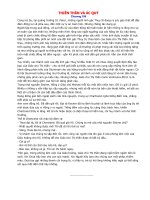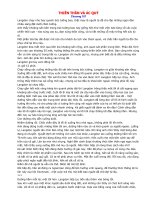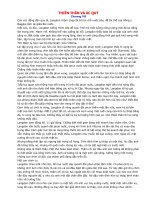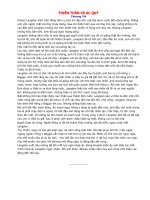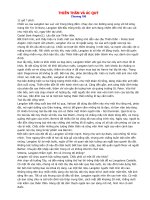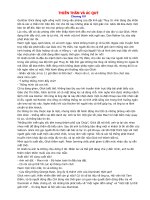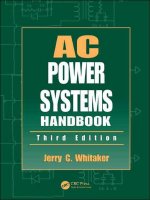flexible ac transmission systems ( (10)
Bạn đang xem bản rút gọn của tài liệu. Xem và tải ngay bản đầy đủ của tài liệu tại đây (324.77 KB, 20 trang )
10 Autonomous Systems for Emergency and
Stability Control of FACTS
The requirement specification in chapter 9 has clearly shown, that the uncoordi-
nated use of FACTS-devices involves some negative effects and interactions with
other devices, which leads to an endangerment of the steady-state and dynamical
system security. This chapter shows one approach to overcome these difficulties
and provides a solution for a coordinated control system fulfilling the specified re-
quirements.
An autonomous control system for electrical power systems with embedded
FACTS-devices is developed that provides the necessary preventive coordination.
With methods of computational intelligence the system automatically generates
specific coordinating measures from specified abstract coordinating rules for
every operating condition of the power system without human intervention or con-
trol. This guarantees an optimal utilization of the technical advantages of FACTS-
devices as well as the steady-state and dynamical system security. Interactions be-
tween the autonomous system and other existing controllers in electrical power
systems are taken i nto consideration so that the autonomous system can com-
pletely be integrated into an existing conventional network control system.
10.1 Autonomous System Structure
The response time of FACTS-devices is in the range of some ten milliseconds. In
case of critical events within the power system, e.g. faults or overloadings,
FACTS- devices r eact immediately to these events due to their short response time.
If the FACTS-devices are not adapted to the situation in and after such a critical
event, this can lead t o an endangerment of the steady-state and dynamical system
security. The Non-Intrusive System Control (NISC) approach in chapter 9 defined
the necessary interactions for regular and emer gency contr ol of FACTS-devices.
As a conseq uence, the application of FACTS-devices requires both a fast coor-
dination of their controllers among one another a nd with power plants, loads, and
conventional controlling devices within the power system. This coordination must
guarantee the steady-state and dynamical system security in the case of critical
events and has to be automatic, quick, intelligent, and preven tive.
The NISC approach has separ ated the planning phase for coordinating actions
from their local execution. One step further goes the autonomous system ap-
proach, where clearly separate d autonomously acting components provide specific
270 10 Autonomous Systems for Emergency and Stability Control of FACTS
tasks. These tasks are in this case system analysis, coordination and execution of
the specified control task. Autonomous systems generally represent an abstract in-
formation-technological framework, which is specified in detail in [1]. Generally
its architecture can be subdivided into several intelligent autonomous components
communicating with each other.
The autonomous components themselves consist of different authorities called
‘management’, ‘coordination’, and ‘execution’. Depending on the control level on
which an intelligent autonomous component is placed, one of the three authorities
dominates compared to the other two authorities. In order to specify the comp o-
nents on each control level every necessary local controller of the process must be
determined concerning its structure. An autonomous component can be a control
station, a process computer or a simple controller.
According to the hierarchical model of a control system for complex technical
processes, e.g. electric power systems, the different control levels are called:
• network c ontrol level,
• substation control level,
• bay control level.
Bay Control Level. The physical coupling of the autonomous components on the
bay control level is realized by sensors and actuators. The main task at the bay
control level is ‘execution’, i.e. in this context mainly the application of control
and adaptation algorithms.
Substation Control Level. Autonomous components on the substation control
level mainly act as coordinators. They determine and plan the functionality of
other components and delegate distinct special tasks.
Network Control Level. On the network control le vel autonomous components
are working with information being generated from a model of the whole process,
which can be implemented on this control level. The most important task of these
components is the decompos ition of global aims being generated here or pre-
scribed by a human operator through t he human-machine-interface.
The m ain capability of an autonomous control system is t o act automatically
without manual interactions. The autonomous system shall provide the following
features:
• perform self-learning, self-organization, and can plan and optimize control ac-
tions,
• decentralized artificial intelligence enables quick autonom ous actions.
• automatically adaptation to changes of the technical process in structure and pa-
rameters,
• operation of the process w ithout human intervention.
To achieve this, some kind of knowledge about the required coordinating actions
and adaptations must be embedded into the system on the specific levels. As a so-
lution coordinating generic rules can be defined which are valid in any power sys-
10.2 Autonomous Security and Emergency Control 271
tem. These rules have to be adapted b y a system analyses to the specific opera-
tional conditions.
10.2 Autonomous Security and Emergency Control
10.2.1 Model and Control Structure
In the following the autonomous system control will be demonstrated by the
means of UPFC. The reason is that the UPFC provides fast power flow, voltage
and damping control and therefore requires especially t he coordinating c ontrol
scheme. Other simpler FACTS-device controls can be derived from this general
structure.
As shown in Fig. 10.1 the dynamic behavior of a UPFC can be modeled by a
current source injecting the shunt current
q
I
and a voltage source inserting the
longitudinal voltage
l
V . The dynamics of the two VSC are modeled by first order
time delay elements (PT
1
-Elements) with a time constant in the range between 1 5
and 3 0 ms [2].
In the model, the outputs of the operating point controllers are directly used by
the converter control model for the calculation of
l
V and
q
I
. Furthermore a con-
troller for improving the small signal stability of the system (damping controller)
is implemented which will be dealt with in section 10.3. The outputs being fed
back by the controller are the deviations from the setpoint values of acti ve-power
(
∆
P
ij
), reactive-power (
∆
Q
ij
), nodal voltage (
∆
V
i
) and the corresponding serial cur-
rent (
∆
I
l
). The controller function is defined in equation 10.1. Its input and output
vectors are defined in equations 10.2 and 10.3.
yFu ǻǻ −= (10.1)
()
T
lijiji
IPQV ∆∆∆∆=yǻ (10.2)
()
T
DPDQDV
uuu
,,,
∆∆∆=uǻ (10.3)
10.2.2 Generic Rules for Coordination
Coordination for the steady-state operation can e.g. be performed using optimal
power flow tec hniques [3]. Concerning the dynamical operation, an adaptation of
the control operations by FACTS-devices to changing operating situations or criti-
cal events in the power system has to be performed.
272 10 Autonomous Systems for Emergency and Stability Control of FACTS
Critical events, which require coordinating control measures to be applied to
the embed ded FACTS-devices, are:
• overloading of electrical devices,
• failure of electrical devices,
• short circuits in transmission elements,
• changes of the system’s state.
Necessary coordinating control measures have to be applied in short term range
after the occurrence of one of the above-mentioned events. The first three events
are emergency cases requiring fast actions. The forth one concerns t he damping
control and will be analyzed in section 10.3.
The coordinating control measures can be formulated in a knowledge-based
form as so-called generic rules [4]. Before they will be listed and explained, the
definition of the terms 'control path' and 'parallel path', which concern the network
topology, has to be given (see Table 10.1). For illustration, the topology of a s im-
ple example po wer system including one UPFC is shown in Figure 10.2.
Im{V
l
' }
Re{V
l
' }
I
q
feedback variables P
ij
,Q
ij
,V
i
,I
l
dynamic model of electric power system
converter control
{
}
l
VRe
{
}
l
VIm
{
}
q
IIm
{
}
q
IRe
UPFC mode l
l
V
q
I
i
V
j
V
l
I
U PFC converter model
il
VI ,
i j
P
ij, ref
Q
ij, ref
V
i, ref
operating point
controllers
voltage
controller
reactive-power
flow controller
active-power
flow controller
PT
1
PT
1
PT
1
PT
1
damping
controller
I
l, ref
+
-
+
+
+
-
-
-
+
+
+
+
+
+
Fig. 10.1. UPFC modeling and control
10.2 Autonomous Security and Emergency Control 273
Table 10.1. Definition of terms
Term Definition
control path transmission path in which a power flow controlling device (e.g. UPFC)
is implemented and which only has junctions at its end-nodes
parallel path transmission path which starts and ends at the same nodes as a control
path and in which no power flow controlling device is implemented
The existence of a parallel path is an essential necessity for a power flow con-
trolling FA CTS-device. Controlling the power flow over its control path a
FACTS-device shifts the power flow f rom its control path to parallel paths and
vice versa.
A system theoretical analysis shows the following four coordinating control
rules:
1. IF a device on a parallel path of a FACTS-device is overloaded,
THEN modify the P-setpoint-values of the FACTS-device
A power flow controlling FACTS-device can directly influence the active and re-
active power flow over its control path. This leads to the above-mentioned shift of
the power flow from the control path to parallel paths or vice versa. Consequently,
power flows over parallel path s can be specifically influenced by changing the set-
point values for the active- and reactive-power flow of the control path. In this
way overloadings of devices on parallel paths can be suppressed by changing the
setpoint values of a power-flow controlling FACTS-device. The control path takes
over the surplus of power flow which otherwise leads to the overloading of the
device(s) on a parallel path.
This rule recommends modifying only the P-setpoint-values of FACTS-devices
to suppress overloadings because these are mainly caused by active power flows.
The reactive power-flow controlling functions of a FACTS-device can then be
used for voltage control.
control path
parallel path
UPFC
Fig. 10.2. Simple example power system used for definition of contro l and parallel paths
274 10 Autonomous Systems for Emergency and Stability Control of FACTS
2. IF there is a failure of a device on a parallel path AND no further parallel pat h
exists for a FACTS-device
THEN deactivate the power flow controllers of the FACTS-device
The existence of at least one parallel path to a control path is an important condi-
tion for the reasonable application of the power flow control function of a
FACTS-device. As already described above, power flow control causes a shift of
the power flow between control path and parallel path(s). Hence, if a failure of a
device causes an opening of all parallel paths, the power flow control of a
FACTS-device is hindered. The consequence would be that t he outputs of the
FACTS-device's power flow controllers would ru n into their limits, which may
cause strong system oscillations. This is called 'false controlling effect', which
means that the power flow controllers try to meet the given setpoint values, but
they cannot reach them because power fl ow can not be shifted to parallel paths.
According to the NISC requirements this needs to be avoided. By quickly deacti-
vating the power flow controllers after such a failure the false controlling effect
can eff ectively be prevented.
3. IF a sh ort circuit happens on a control path or on a parallel path of a FACTS-
device,
THEN slow down the operating point controllers of the FACTS- de vice
This coordinating measure prevents excessive power oscillations after a short cir-
cuit followed by automatic reclosing. The reason for this is that the power flow
changes drastically during the short circuit. Mainly, a high reactive current flows
over every line into the direction of the short circuit location. Because of the short
response time of the FACTS-devices the power flow controllers respond immedi-
ately to the short circuit and try to meet the preset setpoint values. Also the voltage
controller tries to fix the setpoint-voltage. Hence, the outputs of the operati ng
point controllers will strongly increase within a short period of time and reach
their limits even before the fault is clarified and the automatic reclosing is started.
When the fault is removed after an automatic reclosing these large values of the
manipulated variables of the operating controllers lead to strong oscillations. This
is another kind of false co ntrolling effect and has to be suppressed by suitable
measures. Through slowing down the power flow controllers and the voltage con-
troller during the short circuit and the automatic recl osing (decreasing of the PI
controller parameters) this f alse controlling effect can be prevented.
The correct application of these three coordinating measures to FACTS- devices
and their control enables the network operators to exploit the advantages being of-
fered by FACTS for their steady-state an d dynamical secure operation. The
autonomous control system is designed to execute them automatically.
10.2.3 Synthesis of the Autonomous Control System
Due to the continuous c hanges of the operating states and the topolo gy during the
daily operation through varying loads, generations and switching operations, the
10.2 Autonomous Security and Emergency Control 275
specific coordinating control measures must be followed up automatically to these
changes. Only under this condition the controller is able to react adequately on
critical events in the changed system. This guarantees a dynamical and stationary
secure behavior of the whole system. To ensure a quick reaction of the autono-
mous system, the specific c oordinating measures have to be derived, before a
critical event occurs. Hence, topolo gy-changes of the network have to be analyzed
continuously. This continuous adaptation of the specific coordinating measures for
changing topologies is called 'preventive coordination' being performed by the
autonomous control system. The three coord inating generic rules, which have
been explained in t he previous section, are the elementary tasks, which have to be
fulfilled by the autonomous control system.
These first three rules mainly concern setpoint values f or the operating point
controllers and the operating controller's parameters. The development of the
autonomous system is performed successively starting at the bay control level.
Some elementary autonomous compo nents ar e chosen and designed to be acting
on this control level. After that, additional autonomo us co mponents on the other
control levels are added. They provide the components on the bay control level
with necessary specific information, which is generated automatically in depend-
ence on the actual network topology.
10.2.3.1 Bay Control Level
Figure 10.3 shows the operating point controllers of a UPFC, which are extended
by the additional controllers as autonomous components on the bay control level.
They perform the basic measures, which are required by the first three generic
rules and are explained in the following.
The coordinati ng measure given by the first generic rule requires a modification
of the P-setpoint value of the UPFC in order to prevent overloadings on lines on
its parallel paths. A simple but effective autonomous component performing this
can be an integral-action controller forming an outer control loop. The actual ac-
tive-power fl ows over all lines on parallel paths have to be observed by the
autonomous component. As the degree of freedom for influe ncing power flows
over parallel paths of one FACTS-device is equal to one. A UPF C can at the same
time specifically prevent o nly one overloaded line. If several overloadings are de-
tected, the line with the biggest overloading is chosen.
The actual deviation from the maximum allowed active power flow (P-P
max
),
which has a positive value in case of an overloading, is taken as the input of the
integral-action controller. T his way it adjusts the setpoint of the active-power flow
controller of the UPFC until the acti ve-power flow of the overloaded line is re-
duced to its maximum allowed value P
max
. This is the basic idea of how the first
generic rule is implemented on the bay control level. It guarantees the steady-state
security of the power system.
276 10 Autonomous Systems for Emergency and Stability Control of FACTS
When using this method in practice several additional measures have to be im-
plemented. This comprises e.g. the detection if the reason of an overloading has
disappeared after the overloading has been removed by the integral-action control-
ler. In this case the setpoint adjusting by the integral-action controller has t o be re-
set. Another important issue is the detection if an overloading is permanent or only
temporary. Temporary overloadings can appear in case that the active power flow
over a line oscillates around a value, which is directly below the maximum capac-
ity. Those temporary overload ings are usually uncritical because they do not cause
thermal problems. Hence they do not have to be treated by the autonomous control
system. Additionally, it has to be respected that not all overloadings of lines on
parallel paths can be removed by the P-setpoint adjusting. It strongly depends on
the impact of a FACTS-device on the power flow of parallel paths, which can be
high or very low. In case the impact is very low, usually a very big change of the
P-setpoint is required for removing the overloading. As the UPFC has only limited
control power, the setpoint adjusting will probably not be successful when trying
to remove the overloading. These and further specific aspects are very important
for the implementation of the method.
The second generic rule requires a deactivation of the power flow controllers in
case of failures of distinct devices on parallel paths. The d eactivation of t he con-
Q
ij, ref
P
ij, ref
fuzzy
modu le 1
integral-action
controller
setpoint a djusting
parameter adaption
voltage-
controller
k
s
(P-P
max
)
of lines on
parallel
paths
reactive-power
flow controller
active-pow er
flow controller
choosing of
the biggest
ov erloading
measured
values o f lines
on parallel
paths and the
control path
fuzzy
module 2
parameter adaption
P
ij
V
i, ref
Q
ij
V
i
+
+
+
-
-
-
+
Fig. 10.3. Operating point controllers of a UPFC with autonomous components on the bay
control level
10.2 Autonomous Security and Emergency Control 277
trollers shall be performed by quickly setting the controller parameters of the ac-
tive and reactive power flow controller to zero. Adaptive control is chosen to be
suitable for thi s. Since fuzzy adaptation provides a transparent knowledge based
implementation of adaptation rules, a fuzzy module is chosen to be the autono-
mous com ponent on the bay control level performing this task (fuzzy module 1).
In addition, such a fuzzy adaptation produces soft transitions between the acti-
vation and deactivation of the controllers. The knowledge bases are derived from
the generic rule 2. This is performed by autonomous components on higher con-
trol levels and will be described in a later section. The input quantities of the fuzzy
controller must be measured values of lines on parallel paths. From these input
quantities the fuzzy controller must be able to clearly recognize failures of rele-
vant transmission elements. Measurements of the currents or complex power
flows o ver the concerning transmission elements can be taken as input quantities.
Membership functions for the input quantities ha ve to be chosen once and remain
valid for all operating cases.
The implementation of the third generic rule on the bay control level is also
done by a fuzzy controller performing an adaptation of the parameters of the oper-
ating co ntroller (fuzzy module 2). It decreases the operating point controller's pa-
rameters in cases of short circuits on lines of the control path or on parallel paths
so that the controllers are slowed down strongly, as it is required according to ge-
neric rule 3.
Short circuits (faults) must be reliably recognized by the input quantities of the
fuzzy controller. Hence, the currents over those lines can be taken as input quanti-
ties for the fuzzy controller. Also here the membership functions have to be cho-
senonlyonce.
10.2.3.2 Substation and Network Control Level
Autonomous components on the substation and the network control level have to
generate specific additional information for the autonomous components on t he
bay control level (fuzzy modules, integral-action controller and damping control-
ler). This must also be based on the generic rules.
The generic rules strongly depend on the network topology. They use the terms
'control path' and 'parallel path' as they have been defined above. For this r easo n,
autonomous components on the networ k control level have at first to anal yze
automatically the network’s topology. This is done recursively with the known
backtracking technique. The result is an assignme nt of all parallel paths to each
control path. For large and complex networks these calculations can t ake long
computation time because theoretically a large number of parallel paths may exist.
However, since the impact on parallel paths that are far away from the control
path may be very small, the user can define a reasonable area of impact for each
FACTS- device, in which it has sufficient impact on its parallel paths. These areas
should be chosen such that the influence of the power flow over lines within the
areas can be performed with a realistic amount of control power. The analysis of
the netw ork’s topology for fin ding control and parallel paths can then be limited to
these areas of impact.
278 10 Autonomous Systems for Emergency and Stability Control of FACTS
With the result of the topology analysis the three generic rules can be brought
to a set of concrete coordinating rules, which are valid for the actual network to-
pology. To illustrate this, one example of a concrete rule for each generic rule
shall be given:
1. IF line 11-19 is overloaded THEN modify the P-setpoint-values of UPFC 2
2. IF there is a failure of line 17-18 THEN deactivate t he power flow controllers
of UPFC 1
3. IF a short circuit happens on line 11-19 THEN slow down the operating point
controllers of UPFC 2
This is how the rules ma y look li ke for an example real power system containing
UPFCs. The complete sets o f concrete coordinating rules may contain a large
number of rules.
For the generic rules 2 and 3 the concrete rules are then translated by autono-
mous components into fuzzy rule bases for the fuzzy modules 1 and 2 on the bay
control level for each FACTS-device. The rule bases are downloaded into the
fuzzy modules 1 and 2.
Concerning generic rule 1 the result of the topology analysis is u sed by a fur-
ther autonomous component to compute the impact of the FACTS-devices on
lines on parallel paths. It computes the GSDF (generation shift distribution factors,
[5]) in order to quantify the impacts of FACTS-devices on all lines of the parallel
paths. Only if the impact of a FACTS-device on a line is big enough, it is sensible
to include this line into the autonomous control in terms of preventing overload-
ings. If more than one FACTS-device has a certain impact on a line, the FACTS-
device with the biggest impact on that line is determined to remove a possibly oc-
curring overloading. This way the GSDF determine the lines, which have to be
monitored by which FACTS-device with regard to overloadings. They also deter-
mine the parameters k of the integral-action controllers. This mainly concerns the
sign of the control action, which means if the P-setpoint has to be increased or de-
creased to remove a specific overloading of a transmission element.
In this way it can be guaranteed that the integral-action controllers perform
their control actions to r emove overloadings with t he correct direction a nd the
necessary intensity.
Figure 10.4 finall y shows the autonomous components, which are necessary on
the substation and the network control level in order to generate specific informa-
tion for the fuzzy modules and the integral-action controllers as autonomous com-
ponents on the bay control level.
10.2 Autonomous Security and Emergency Control 279
10.2.3.3 Preventive Coordination
As already me ntioned before, the specific information for fuzzy and integral-
action controllers (fuzzy rule bases etc.), which represent the coordinating meas-
ures in the case of overloadings, faults, and failures, is only valid for the network
topology for which they have been generated. Since the topology of the system
changes in the daily operation of the power system by switching operations, the
fuzzy rule bases and additional information for the integral controllers m ust be fol-
lowed up automatically to these modifications. Only under this condition it is
guaranteed that the autonomous system can react correctly to critical events ac-
cording to the above-mentioned generic rules. Such planned cha nges of the net-
work topology are named in Fig. 10.5 with 'intended topological changes'. In addi-
tion, the occurrence of critical events, to which the autonomous system reacts by
means of fuzzy parameter adaptation or setpoint adjusting, itself may lead to a
changed topology, f or instance thr ough the unintentional failure of a transmission
line.
substation
and
network
control
level
gene ric rules 1, 2, 3
automatic generation
of fuzzy rule b ases
autom atic analysis of
network t opology with
backtracking algorithm
z
control path
z
all parallel paths
for every
FACTS-device
computing t he impact of the FACTS-
device on parallel paths w ith GSDF
determ ination of the lines to be
monitored and the parameters k
comp lete
fuzzy
rule bases
± k
s
fuzzy modules 1 and 2
establishment of
concrete rule bases
bay
control
level
Fig. 10.4. Autonomous components on the substation and network control level for generic
rules 1, 2 and 3
280 10 Autonomous Systems for Emergency and Stability Control of FACTS
For both cases of topology changes the previously described procedures for the
generation of specific information for fuzzy and integral-action controllers being
performed by autonomous components on the substation and the network control
level have to be activated automatically.
Hence, new specific information is generated for the autonomous components
on the bay control le vel. This is called 'preventive coordination'. The term 'normal
operational state' means that at the moment no certain coordinating action of the
autonomous system is required so that only the operating point controllers are in
normal operation. 'Target of autonomous control reached' indicates that an over-
loading has been successfully removed or that operating point contr ollers have
successfully been slowed down or deactivated in order to prevent false controlling
effects respectively.
normal operational state
critical e vent
autonomous control:
parameter adaptation,
setpoint adjusting
target of autonomous
control reached
topology
changes ?
preventive coordination
analysis of the network‘s topology
generating specific informat ion for fuzzy and
integral-action controllers according to Fig. 9.6.
download to autonomous com ponents on bay control lev el
intended topological
changes
no
yes
Fig. 10.5. Procedure for preventive coordination of FACTS-devices
10.3 Adaptive Small Signal Stability Control 281
10.3 Adaptive Small Signal Stability Control
From a control systems the ory point of view, an electric power system behaves
like a non-linear, time-variant controlled system. Due to permanent chan ges of
power generation, loads, and the networks topology, the dynamical state of the
system varies strongly an d continuously. FACTS-devices, which are equipped
with simple damping controllers like a li near output feedback controller, shall im-
prove the small signal stability of a power system during all its operating condi-
tions. Therefore the contr olle r has to be c ontinuously adapted according to the
changes of the dynamical states, which happen to the entire system.
The damping controller in Figure 10.1 is usually implemented to work in paral-
lel to the operating point controllers, which means that the outputs of the damping-
controller are added to the outputs of the operating point controllers. For example
an output feedback controller with adaptable parameters can be used t o improve
the system's small signal stability. This controller is linear and it is usually param-
eterized for a power system model being linearized around an operating point.
Constant parameter settings can usually only guarantee good control performance
for the system operating around this point and not withi n the whole range of states
in which it can operate. Hence, the damping controller parameters are to be
adapted to changes of the system’s state.
A fourth generic rule can be formulated to take this requirement into account.
4. IF a change of the dynamical state of the entire system happens,
THEN adapt the parameters of the FACTS-device's damping controller.
10.3.1 Autonomous Components for Damping Control
The damping controller is designed as an output feedback controller whose feed-
back matrix F has to be adaptable to changing conditions of the power system ac-
cording to generic r ule 4.
The bay control level does not contain any specific autonomous components for
the adaptation of the dam ping controller since information about the whole sys-
tem’s state can only be provided from the entire power system point of view, i.e.
from the network control level.
Autonomous components on the network and substation control level have to
determine the damping controller parameters, i.e. the elements of the output feed-
back matrices F of each FACTS-device be ing fitted with such a damping control-
ler. As already done in the previous sections of this chapter, the ideas and concepts
of how this is performed shall be revealed instead of presenting all details about
their implementation.
As mentioned above, loads, generations and the network’s topology determine
the dynamical state of the power system as a controlled system, its input variables
and its equivalent transmissi on function. The no n-linear system e quations for a
current operatin g point can be linearized around this operating point, such that a
set of linear coupled differential equations is received. Hence, the power system
282 10 Autonomous Systems for Emergency and Stability Control of FACTS
can be described as a first-order state space model, which is valid in a certain envi-
ronment around the chosen operating point.
The computation of the eigenvalues of the system matrix A gives information
about its oscillatory characteristics, e.g. critical modes. Critical oscillation modes
are m odes with a small or even negative damping rati o. Furthermore, the eigen-
values have to be computed by an autonomous component in order to determine
the modal transformation of the system. This is also done on the network control
level. Regarding the input matrix B
m
of the modal transform ed system it ca n easily
be analyzed, which FACTS damping controller has got a strong influence on
which of the critical oscillation modes of the system.
The autonomous components assi gn to the critical mode with the lowest damp-
ing ratio one FACTS-device, whose damping controller has the biggest influence
on that mode. The remaining FACTS-devices are then one by one assigned to
other critical modes with higher damping ratios.
Using this selection and some further information, like the damping sensitivity
factors (DSF) [6], a cost function is formulated which expresses the effectiveness
of a chosen parameter set for the FACTS damping controllers, concerning the re-
sulting damping rati os of the critical modes in the closed-loop operation. This cost
function is t hen minimized using the well known Simulated Annealing algorithm
as a numerical optimization technique [7] in order to determine the optimal output
feedback control matrices F
i
for each e xisting FACTS damping controller and the
present system's state. Fig. 10.6 illustrates the whole described procedure being
performed by autonomous components on the network control level in order to
compute optimal FACTS damping controller parameters after a change of the dy-
namical state of the entire system.
10.4 Verification
In the following, two simulation examples are shown in order to illustrate the per-
formance of the autonomous control system. For the investigations the example
network according to Fig. 10.7 has been analyzed. The fuzzy rule bases and global
information for integral controllers were generated with the described autonomous
system, which has also been implemented into a simulation environment.
A failure of a transmission line and the scenario of a line overloading caused by
a rapid increase of a load is simulated. In this way the effectiveness of the coordi-
nating measures through generic rules 1 and 2 is shown. The per-unit quantities of
the u sed example power system are: S
b
= 1250 MVA and U
b
= 400 kV.
The example system is derived from the extra-high voltage level of large power
system, which has been r educed to the essential transmission elements, generators
and loads.
10.4 Verification 283
uDxCy
uBxȁx
mm
mmm
ǻǻ
ǻ
+=
+=
()
()
ux,gy
ux,fx
=
=
uDxCy
uBxAx
ǻǻǻ
ǻǻǻ
+=
+=
ȖįȜ j+=
iii
yFu ǻǻ −=
information about
loads, generations, netw ork topology
non-linear
system equations
linearized
system equations
eigenvalues
m odal transformed
system equations
assignment of FACT S dev ices to
critical modes
optimization of a cost function w ith
simulated annealing
optimal cont roller
matrices F
i
Fig. 10.6. Procedures being performed by autonomous components on the network control
level for the automatic adaptation of FACTS damping controller parameters after changes
of the dynamical system st ate (index i denotes the i-th FACTS-device, if several FACTS-
devices are installed in the power system)
284 10 Autonomous Systems for Emergency and Stability Control of FACTS
10.4.1 Failure of a Transmission Line
AfailureoflineBC1 is assumed. It occurs at t = 0.1 s with a duration of 4.9 s.
Line BC1 has before been cor rectly identified as a part of a parallel path of UPFC
1 by the topology analysis. The results of the automatic topology analysis are
listed in Table 10.2.
The control path of UPFC 1 has only one parallel path. This means that there is
no parallel path existing after the failure of this transmission line. Without
autonomous control the controllers try to keep the setpoint value for active and re-
active power flow over UPFC 1 and produce a large value for V
l
up to its limit of
0.15 pu (see Fig. 10.8). This is due to the false co ntrolling effect. However, the
setpoint values cannot be kept because of the missing parallel path. This large
value of V
l
produces stro ng power oscillations during the failure of the line. They
can be seen in Fig. 10.9.
Table 10.2. Result of the automatic topology analysis
FACTS-device UPFC 1 UPFC 2 UPFC 3
control path
(node numbers)
C1-B3 B3-A3 B1-B2
parallel paths
(node numbers)
C1-B1-B3
B3-B4-B2-A4-A3
B3-B4-A3
B1-B3-B4-B2
B1-B3-B4-A3-A4-B2
UPFC 3
UPFC 2
UPFC 1UPFC 1
'A'
'B'
'C'
CG1
C1
BC2
BC1
B1
BG1 BG2
AG1
AB1
A
B
2
AB3
B2
B3 B4
B1B2
B5
A1
B6
A2
A3
A4
A1A2
Fig. 10.7. Topology of the test system
10.4 Verification 285
When the autonomous control system is in use, fuzzy module 1 for the generic
rule 2 in UPFC 1 reacts immediately by deactivatin g the power flow controllers.
The effect is visible in Fig. 10.8 with the output of the fuzzy module and the re-
sulting outputs of the power flow controllers. The two power flow PI-controllers
of UPFC 1 only cause a small increase of the manipulated variables during the
failure. Consequently, the oscillations in the system are calmer during the failure
than without the application of the autonomous control system.
It has to be mentioned that the shown effect only results from the slowing down
of the controllers in order to prevent the false controlling effect. No FACTS damp-
ing controllers are present within that system. The damping could even be further
improved if FACTS damping controllers were used.
012345678 10
0
0.02
0.04
0.06
0.08
0.1
0.12
0.16
time (s)
with
autonomous control
without
autonomous control
012345678 10
0
1
output of
fuzzy module 1
9
absolute value of series voltage,
V
l
(pu)
0.14
time (s)
9
Fig. 10.8. Series voltage of UPFC 1 (above) and output of fuzzy module 1 of UPFC 1
286 10 Autonomous Systems for Emergency and Stability Control of FACTS
10.4.2 Increase of Load
After an increase of the system loads the primary controllers of the power plants
operate in order to cover the supplementary power requirement. Independent of
this the three UPFC fix the power f lows over the control paths constant w ith their
fast power flow controllers. Consequently, they can for this moment not be used
for the transmission of primary contr ol power.
The capacity of line AB2 is used to approximately 94 % before the load in-
crease. A sloping increase of the system loads of 14 % happens at t =1s.Thepri-
mary control power generated by AG1 has to be transmitted to the load at node B4
e.g. over line AB2, since the control of UPFC 2 fir st keeps t he unchanged setpoint
values. Without the autonom ous control system a non-permissible overloading of
AB2 occurs (see Fig. 10.10). If this condition continued, a tripping of the transmis-
sion line would be inevitable.
In the topology analysis, which has been executed before by the activated
autonomous control system, this line is recognized as an element of a parallel path
to UPFC 2, so that its integral-action controller counteracts directly on the line
overloading and increases the setpoint value for the active power flow (see Fig.
10.10, below). This causes a shift of the p ower flow and a relief of AB2, so that its
maximum loading limit of 0.62 pu (active power) can be kept (see Fig. 10.10,
above). At t = 1000 s the loads are decreased to their original values, which means
that the reason for the overloading has now disappeared. This has been simulated
to show that the autonomous control system is able to reset itself when its coordi-
nating control actions are not needed any more. The integral-action controller re-
duces its output back to zero.
01 234 5678 10
0.8
0.9
1
1.1
1.2
time (s)
with autonomous control
without
autonomous control
9
active
power
flow
of UPFC1 / pu,
Fig. 10.9. Active power flow over UPFC 1
10.4 Verification 287
In conclusion, the use of FACTS-devices offers a flexible management of net-
work-operation from a technical and economical point of view. Beyond this they
may cause many negative effects, which occur due to their short response time af-
ter critical events. Hence their advantages can only be used if automatic, quick, in-
telligent, an d preventive coordinating measures are perfor med to eliminate those
negative effects. The theory of autonomous systems offers a structural approach
for a coordinating control system for FACTS-devices. The necessary coordinating
measures, which have to be executed by an autonomous control system, can be
formulated as four generic rules. An autonomous control system has been devel-
0 5 10 1000 1005 1010 1015
0.56
0.58
0.6
0.62
0.64
0.66
0.68
time (s)
without autonomous
control
with autonomous
control
p
max
=0.62pu
active power
flow of line
AB2
/pu
0 5 10
0.3
0.32
0.34
0.36
0.38
0.4
0.42
time (s)
without
autonomous control
with autonomous
control
active
power
flow of UPFC 2 / pu
1000 1005 1010 1015
~
~
~~
~
~
~
~~
~
~
~
~~
~
~
~
~~
~
~
~
~~
~
~
~
~~
~
Fig. 10.10. Active power flow over line AB2 (above) and active power flow over UPFC 2
(below)
288 10 Autonomous Systems for Emergency and Stability Control of FACTS
oped and implemented for such a coordination s o that the steady-state and dy-
namical system security is guaranteed after critical events. It automatically applies
the four generic rules for every operation condition of a power system. The control
system specifies the generic rules within several steps and on different control lev-
els so that concrete information is made available f or decentralized autonomous
components. For this, several techniques of Computational Intelligence, such as
Fuzzy Control and Simulated Annealing, as well as conventional control tech-
niques are applied. The co ncrete information consists e.g. of fuzzy r ule bases and
damping controller parameters and is generated preventively. Hence, the reaction
of the system is as fast as possible and correct for the present operating condition
of the power system.
An open question in this section is how exchange online information between
the parallel path, which means remote lines, and the FACTS controller. The fol-
lowing se ction will answer this question with wide a rea control systems. Another
open issue is the basic design of the damping controller, because this chapter has
only introduced a solution for the automatic adaptation, but not for the design it-
self.
References
[1] Rehtanz C (2003) Autonomous Systems and Intelligent Agents in Power System Con-
tol and Operation, Springer
[2] Cigré Task Force 38.01.08 (1999) Modeling of Power Electronics Equipment
(FACTS) in Load Flow and Stability Programs. Technical Brochure, Cigré SC 38, WG
01.08, Ref. No. 145
[3] Handschin E, Lehmköster C (1999) Optimal Power Flow for Deregulated Systems
with FACTS-devices. Proc. of 13
th
PSCC, Trondheim, Norway
[4] Handschin E, Hoffmann W (1992) Integration of an Expert System for Security As-
sessment into an Energy Management System. Electrical Power & Energy Systems,
vol 14
[5] Wood AJ, Wollenberg BF ( 1996) P ower Generation, Operation a nd Control, 2
nd
Edi-
tion. John Wiley & Sons Inc., New York
[6] Chen XR, Pahalawaththa NC, Annakkage UD (1997) Design of Multiple FACTS
Damping controllers. Proc. of International Power Engineering Conference IPEC
1997, Singapur, pp 331-336
[7] King, RE (1999) Computational Intelligence in Control Engineering. Control Engi-
neering Series, Marcel Dekker, I nc., New York, Basel
